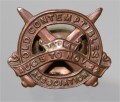- HubPages»
- Education and Science»
- History & Archaeology»
- History of the Modern Era»
- Twentieth Century History»
- World War I
Admiral Sir Roger Keyes, Wwi (World War One, Great War) to 1918
An Illustrious Family Tree of Keyes's And Norman's
Vice-Admiral Sir Roger John Brownlow Keyes, K.C.B., C.M.G., C.V.O., D.S.O., who conceived and personally directed the naval raids on Zeebrugge and Ostend on April 22nd-23rd and May 8th-10th, 1918, was born in 1872.
He was the eldest of four brothers, sons of the late General Sir Charles Patton Keyes and nephews of the late Field-Marshal Sir Henry Wylie Norman and General Sir Frank Norman.
The Fighting Family Keyes
One brother, Lieutenant C. V. Keyes, of the Queen's Own Corps of Guides, was wounded and "mentioned" for his services in the Tirah Campaign of 1899, displayed conspicuous gallantry in Nigeria, and was killed in West Africa in 1901.
Terence, the third brother, also won distinction in the Tirah operations, and earned a brevet-lieutenant-colonelcy and a Companion of the Most Eminent Order of the Indian Empire (C.I.E.) in the Great War.
The younger brother, who was a midshipman in 1901, was promoted commander and gained the Distinguished Service Order (D.S.O.) during the world-conflict.
In the Napoleonic wars three of the forebears of Roger Keyes, all naval officers, were killed in action.
Sixteen of his cousins bore a share in the Great War, two won the D.S.O., two were promoted brigadier-generals, and five "... died for England."
Two of his sisters lost their husbands in action.
Keyes' Services in Chinese Waters
- 1885 - Roger Keyes entered the Navy, and served as a midshipman in the 'Turquoise'.
- 1890 - he took part in the punitive expedition against the Sultan of Vitu, East Africa, under Vice-Admiral the Hon. Sir E. R. Fremantle, gaining the medal and clasp.
- 1893 - he was gazetted lieutenant.
He was on the China station, in command of the torpedo boat destroyer HMS 'Fame', when the Boxer Uprising occurred.
Owing to the shallowness of the water inshore, the garrisons of the Taku forts guarding the mouth of the Peiho River, believing themselves to be secure from reprisals, opened fire on the British vessels. Lieutenant Keyes volunteered to silence them.
The forts were strongly garrisoned and the guns of quite modern type, so his exploit looked to many an impracticable one. After gaining permission, he forced his little craft over the bar and, with a mere handful of men, "… achieved the impossible."
The forts were stormed, captured, and then blown up with explosives from their own magazines.
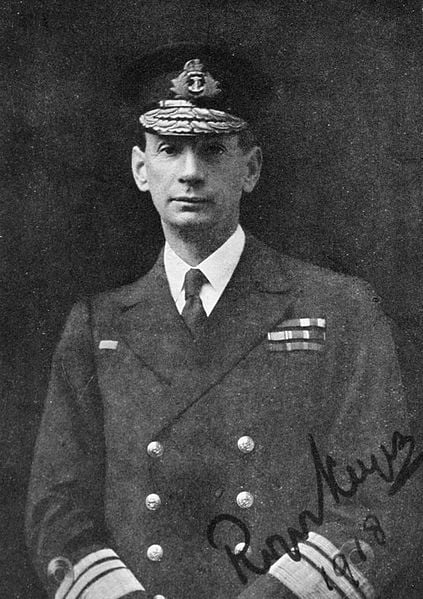
Gallantry in the Peiho River
Following on from this action of combined skill and daring, Lieutenant Keyes, along with the torpedo boat destroyer HMS 'Whiting', "cut out" four Chinese destroyers at no small amount of risk.
The captured boats were shared out between the Allied Navies. The 'Taku' formed part of the German fleet in 1914.
For these services Lieutenant Keyes:
- was mentioned in despatches,
- received "the expression of their Lordships' thorough approbation," from the Admiralty,
- was promoted commander, and
- awarded the medal with two clasps.
A few weeks later, when in command of HMS 'Barfleur':
- he won the Bronze Medal of the Royal Humane Society for jumping into the Peiho River and saving Midshipman R. C. Mayne, who had been swept overboard by a rope.
- 1905 to 1907 - after becoming a captain, he was, in succession, naval attaché in Rome, Vienna, Athens and Constantinople.
- 1906 - in the capitals named he was made:
- Member of the Royal Victorian Order (4th class)
and received, as mementoes of his stays thereat:
- the Order of the Iron Crown (Austria),
- the Order of the Saints Maurice and Lazarus (Italy),
- the Order of the Redeemer 3rd Class (Greece), and
- the Order of Mejidie 2nd Class (Turkey)
- 1906 - Admiral Keyes was married to Eva Mary Salvin Bowlby, daughter of the late Edward Salvin Bowlby.

Drawing the Germans Out in the Bight
Captain Keyes specialised as a submarine and torpedo officer.
- 1910 - November 14th - he was appointed Inspecting Captain of Submarines
- 1911 - he was made a Commander of the Bath (C.B.)
- 1912 - August 31st - he was made commodore in charge of the Submarine Service.
There passed two years of peace.
- 1914 - August 28th - he took part with distinction in the Heligoland Bight affair.
In command of the torpedo boat destroyer HMS 'Lurcher' he led an eight submarines squadron inside the Bight as a decoy to draw out the German fleet.
The ruse succeeded so well that the German light cruisers 'Ariadne', 'Mainz' and 'Koln' were sunk.
The British rescued 220 of the 'Mainz' crew, and escorted the 'Laurel' and 'Liberty' out of action.
These were kept company until supporting British cruisers were sighted.
This action, in addition to the loss it inflicted on the enemy, deflected possible attacks on British Channel transports. It secured for Commodore Keyes special mention in despatches.
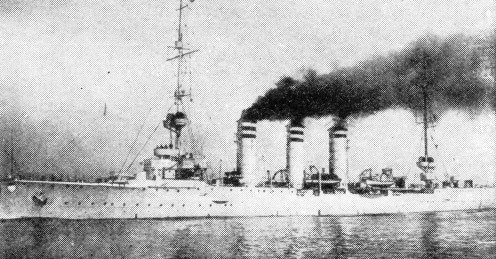
Caption: The German 4,350-ton cruiser 'Koln', which, with its sister ship the Mainz, was sunk in Heligoland Bight on August 28th, 1914.
Keyes at Cuxhaven
- 1914 - December 25th - Commodore Keyes was again in the mine-strewn waters of the Bight following the air reconnaissance of Cuxhaven by British seaplanes.
His craft were subjected to determined attacks from German destroyers, submarines, seaplanes, and Zeppelins; however they remained there until all British airmen had returned.
For this action he was the recipient of "… their Lordships' approbation." once again.

Dardanelles
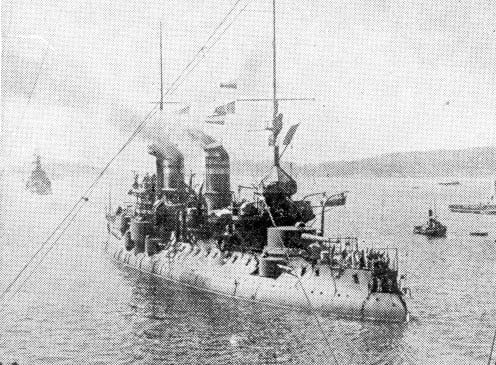
Keyes, Chief-of-Staff in the Dardanelles
- 1915 - Commodore Keyes was chosen as Chief-of-Staff when Vice-Admiral de Robeck was appointed to the supreme command of the forces 'told off' to attempt the passage of the Dardanelles.
The Vice-Admiral officially described his services as "... invaluable."
Keyes devised the dummy warships which deceived the Turkish gunners and drew their fire. In co-operation with Major-General Braithwaite they established "... a most excellent working agreement" between land and sea forces.
- Later in 1915 - he was commended for his service in action during the evacuation of the Gallipoli Peninsula.
- 1916 - January - he was appointed Companion of the Order of Saint Michael and Saint George (C.M.G.)
- 1916 - April - President Poincaré decorated him with the insignia of a Commander of the Legion of Honour.
- 1916 - June - he was awarded the Distinguished Service Order (D.S.O.)
- 1917 - he attained the rank of Rear-Admiral; and shortly afterwards he was made Director of Plans to the Admiralty.
- 1917 - December - when Admiral Sir Rosslyn Wemyss went to the Admiralty, he at once appointed Rear-Admiral Keyes to be Acting Vice-Admiral commanding the Dover Patrol.
Here Keyes had strikingly successful results, especially with his methods for dealing with the submarine menace.
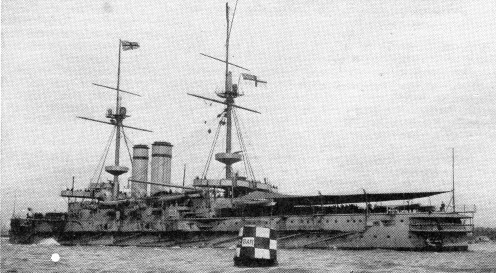
Caption: HMS 'Goliath', torpedoed on the night of May 12th, 1915, just inside the Dardanelles Straits, while protecting the French flank. She sank with the loss of 500 men. The 'Goliath' was an old British 13,000 ton battleship, laid down in 1897 and completed in 1900.
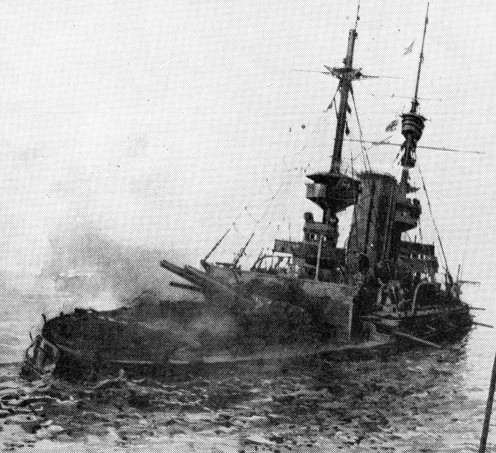
Caption: The ill-fated 'Irresistible', after having been shattered by the explosion of a floating mine in the Dardanelles during an attack on the Narrows' forts on March 18th, 1915. Mines let loose in the Sea of Marmora were carried down by the strong current to the allied ships. After the knock-out blow, the leviathan, listing heavily, drifted towards the beach, the helpless target of Turkish 8in. shells. The crew were transferred to the 'Ocean', and the 'Irresistible' foundered in deep water. Subsequently the 'Ocean' struck a mine and sank, but nearly all the crews of both ships were saved.
Keyes And The Zeebrugge and Ostend Raids
- 1918 - April 23rd - St. George's Day - Vice-Admiral Keyes heroic exploit against the German U boat harbourages at Zeebrugge and Ostend from the torpedo boat destroyer 'Warwick'.
- 1918 - May - Keyes second daring raid on Ostend, also from the torpedo boat destroyer 'Warwick'.
After these two raids, and for the first time, the British public became aware of Admiral Keyes. As a result, the nation felt that he was a man who possessed a rare quality of valour which calculates the chance of success against failure and still takes the risk, and also possessed the power to inspire that valour in others.
- 1918 - June 21st - Admiral Keyes received the accolade from the King as a Knight Commander of the Bath, on the occasion of the investiture at Buckingham Palace.
- 1918 - July - Admiral Keyes was awarded:
- the Croix de Guerre with Palm, by the French Government, and
- the insignia of a Grand Officer of the Order of Leopold, by the King of the Belgians.




